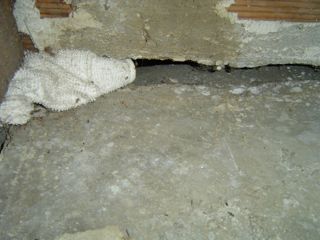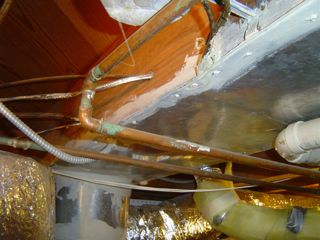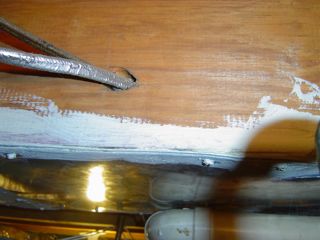
 Sometimes HVAC companies take the easy way out when they install ducts. They may even have done this in your home. I've seen it in many, many homes, and I know as soon as I see it that the duct leakage in that home will be very high. The photo below shows one way you can find them in your home.
Sometimes HVAC companies take the easy way out when they install ducts. They may even have done this in your home. I've seen it in many, many homes, and I know as soon as I see it that the duct leakage in that home will be very high. The photo below shows one way you can find them in your home.
If you have a big grill in the floor like this, you'll most likely see sheet metal at the bottom and wood around the sides. In this case, it's big enough that there's even a joist running right through the middle. What the installer did here was to screw a piece of sheet metal to the bottom of the joists and attach a duct to it to carry the air back to the HVAC system. As we look closer, here's what we see in this house.

Wait. Is that a towel in there?
It sure is! Looks like someone tried to fill the huge gap between the sheet metal and the joist with it, but guess what - towels aren't meant to seal ducts. Air moves through them. Not only that, they didn't fill all the gaps. Every time this system runs, in addition to pulling air from the house back to the furnace or air conditioner to be heated or cooled, it's also pulling a lot of air from the nasty, yucky crawl space below the floor. And then sending that bad air right into the home for the lucky family to breathe. (And when I say lucky, I mean the opposite.)
 In almost all cases, when you see this done, it's on the return side of the duct system, which means that they're pulling air back to the unit to be heated or cooled. Which means that it's under negative pressure. Which means that, when there are leaks, as evidenced by the huge gap above, it's going to pull air from other places besides the house.
In almost all cases, when you see this done, it's on the return side of the duct system, which means that they're pulling air back to the unit to be heated or cooled. Which means that it's under negative pressure. Which means that, when there are leaks, as evidenced by the huge gap above, it's going to pull air from other places besides the house.
Panned joist return ducts are almost always terribly leaky. Those junctions between wood and metal are difficult to seal, and the thermal expansion and contraction of the wood will often cause sealing materials to fail.
Occasionally, I see panned returns where the HVAC company actually tried to seal it up. The photos below show one that I ran across about two years ago.

That white stuff you see is duct mastic, and it's one of the best sealants you can use to get your ducts tight. You should use it generously if you decide to seal up your ducts. There's a saying in the weatherization industry that you should slather it on as "thick as a nickel."
They didn't put it on thickly in the photo above. Worse, they didn't put it everywhere it needed to be, as you can see below.
They put a thin schmear of mastic on the joint between wood and metal, but they completely missed all the big holes — and there were many — drilled through the 'duct' for wiring. They also missed the joints where wood met wood.
As a result, this panned joist return duct sucked in a lot of air from this basement when the furnace or air conditioner were running. Did that cause problems? The photo below shows some of the joists in the vented crawl space that the basement was completely connected to.









